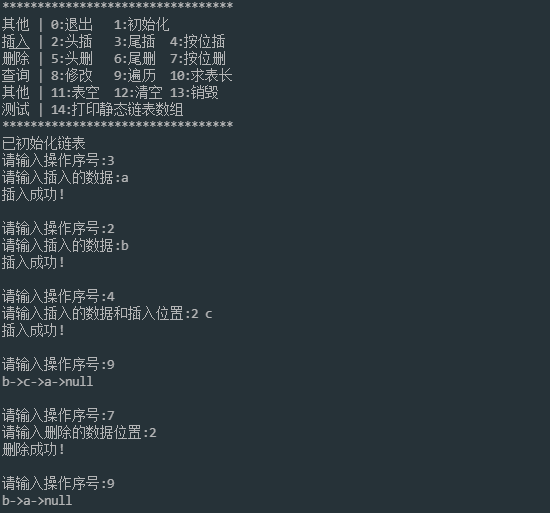数据结构_静态链表(C语言)
数据结构总目录
本章目录
- (一)静态链表图文解析
- (二)静态链表代码解析
-
- 1. 基本操作
-
- 1.1 存储结构
- 1.2 初始化
- 1.3 插入数据
- 1.4 删除数据
- 1.5 修改数据
- 2. 源代码及测试
-
- 2.1 源代码
- 2.2 测试结果
(一)静态链表图文解析
静态链表结构
- 静态链表的结构实际上就是一个数组,静态链表的数组中,每一个元素代表一个结点,结点同样和链表一样包括数据域和指针域
- 只是在静态链表中的指针域不再是指针指向下一个结点的地址,而是用于存储下一个结点的数组下标,这样同样可以实现结点之间的连接关系
图示
在静态链表中
(二)静态链表代码解析
1. 基本操作
1.1 存储结构
#define MaxSize 10 //最大链表长度
typedef char DataType;
typedef struct LNode
{
DataType data; //数据域
int next; //指针域
}StaticList;
1.2 初始化
void InitList(StaticList **L)
{
// 为静态链表分配空间
(*L) = (StaticList *)malloc(MaxSize * sizeof(StaticList));
// 初始化头结点
StaticList *s = *L;
s[0].data = '\0';
s[0].next = -1;
// 初始化链表
int i;
for (i = 1; i < MaxSize; i++)
{
s[i].data = '\0';
s[i].next = -2;
}
printf("已初始化链表\n");
}
1.3 插入数据
头部插入
void HeadInsert(StaticList *L)
{
if (L)
{
DataType x;
printf("请输入插入的数据:");
fflush(stdin);
scanf("%c", &x);
// 获取新结点的下标位置
int free_node = GetFreeNodeIndex(L);
if (free_node > 0)
{
// 设置新结点的数据
L[free_node].data = x;
// 新结点指向链表的第一个结点
L[free_node].next = L[0].next;
// 头结点指向新结点,使得新结点成为链表的第一个结点
L[0].next = free_node;
printf("插入成功!\n");
}
else
{
printf("插入失败! 链表空间已满!\n");
}
}
else
{
printf("插入失败! 链表已销毁!\n");
}
}
尾部插入
void TailInsert(StaticList *L)
{
if (L)
{
int i;
DataType x;
printf("请输入插入的数据:");
fflush(stdin);
scanf("%c", &x);
int free_node = GetFreeNodeIndex(L);
if (free_node > 0)
{
int tail_index = 0;
// 查找尾结点下标
while (L[tail_index].next > 0)
{
tail_index = L[tail_index].next;
}
// 设置新结点数据
L[free_node].data = x;
// 新结点指针域设置为空
L[free_node].next = -1;
//尾结点指向新结点,使得新结点成为链表的最后一个结点
L[tail_index].next = free_node;
printf("插入成功!\n");
}
else
{
printf("插入失败! 链表空间已满\n");
}
}
else
{
printf("插入失败! 链表已销毁!\n");
}
}
按位置插入
void LocateInsert(StaticList *L)
{
if (L)
{
int i, k;
DataType x;
printf("请输入插入的数据和插入位置:");
scanf("%d %c", &k, &x);
int free_node = GetFreeNodeIndex(L);
if (k > 0 && free_node > 0)
{
int insert_index = 0;
// 查找链表中第(k-1)个结点
while((--k) && L[insert_index].next > 0)
{
insert_index = L[insert_index].next;
}
// 插入新结点
if (k == 0)
{
// 设置新结点数据
L[free_node].data = x;
// 新结点指向第k个结点下标
L[free_node].next = L[insert_index].next;
// 第(k-1)个结点指向新结点
L[insert_index].next = free_node;
printf("插入成功!\n");
}
else
{
printf("插入失败! 插入位置不合法!\n");
}
}
else
{
printf("插入失败! 插入位置不合法/链表空间已满!\n");
}
}
else
{
printf("插入失败! 链表已销毁!\n");
}
}
1.4 删除数据
头部删除
void HeadDelete(StaticList *L)
{
if (L)
{
if (L[0].next > 0)
{
int first_index;
// 获取第一个结点
first_index = L[0].next;
// 头结点指向第二个结点
L[0].next = L[first_index].next;
// 初始化第一个结点
L[first_index].data = '\0';
L[first_index].next = -2;
printf("删除成功!\n");
}
else
{
printf("删除失败! 链表为空!\n");
}
}
else
{
printf("删除失败! 链表已销毁!\n");
}
}
尾部删除
// 尾部删除
void TailDelete(StaticList *L)
{
if (L)
{
if (L[0].next > 0)
{
int i = 0, j = 0;
// 查询倒数第一个结点(i)和倒数第二个结点(j)
while (L[i].next > 0)
{
j = i;
i = L[i].next;
}
// 倒数第二个结点指向-1
L[j].next = -1;
// 初始化最后一个结点
L[i].data = '\0';
L[i].next = -2;
printf("删除成功!\n");
}
else
{
printf("插入失败! 链表为空!\n");
}
}
else
{
printf("插入失败! 链表已销毁!\n");
}
}
按位置删除
// 按位置删除
void LocateDelete(StaticList *L)
{
if (L)
{
int k;
printf("请输入删除的数据位置:");
scanf("%d", &k);
if (k > 0 && L[0].next > 0)
{
int i = 0, j = 0;
// 查询第(j = k-1)个结点和第(i = k)个结点
while ((k--) && L[i].next > 0)
{
j = i;
i = L[i].next;
}
if (k < 0)
{
// 第(k-1)个结点指向第(k+1)个结点
L[j].next = L[i].next;
// 初始化第k个结点
L[i].data = '\0';
L[i].next = -2;
printf("删除成功!\n");
}
else
{
printf("删除失败! 删除位置不合法!\n");
}
}
else
{
printf("删除失败! 链表为空!\n");
}
}
else
{
printf("删除失败! 链表已销毁!\n");
}
}
1.5 修改数据
// 修改链表
void ListModify(StaticList *L)
{
if (L)
{
int k;
DataType x;
printf("请输入需要修改的位置和修改后的数据:");
scanf("%d %c", &k, &x);
if (k > 0)
{
int index = 0;
// 查询第i个结点位置
while ((k--) && L[index].next > 0)
{
index = L[index].next;
}
if (k < 0)
{
L[index].data = x;
printf("修改成功!\n");
}
else
{
printf("修改失败! 修改位置不合法!\n");
}
}
else
{
printf("修改失败! 修改位置不合法!\n");
}
}
else
{
printf("链表已销毁!\n");
}
}
2. 源代码及测试
2.1 源代码
#include


